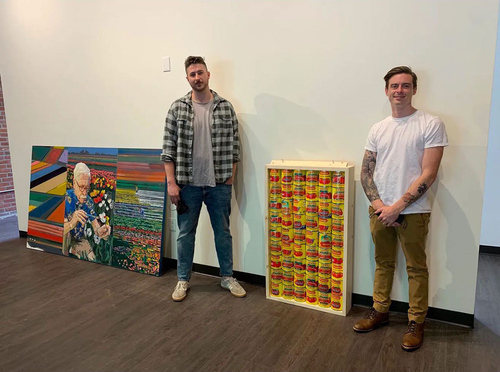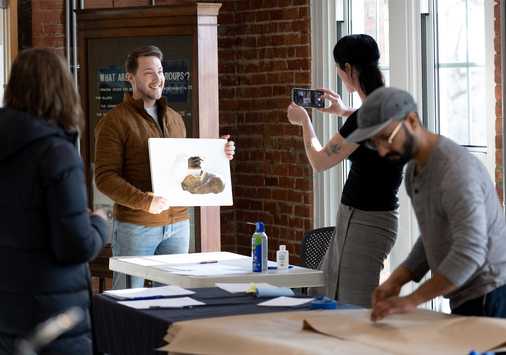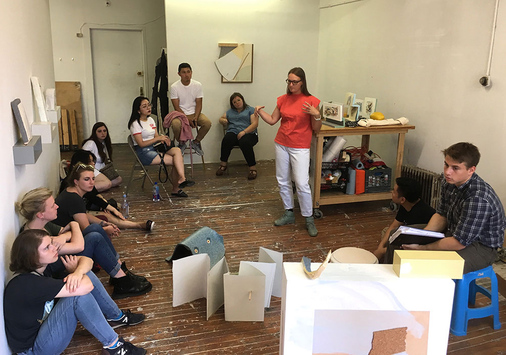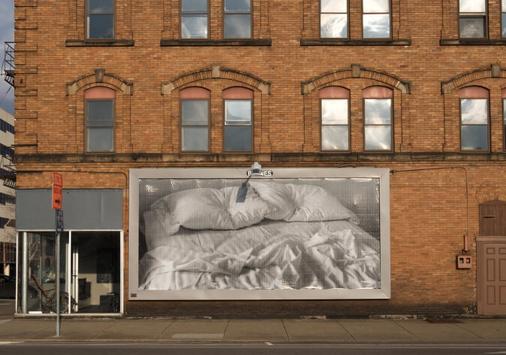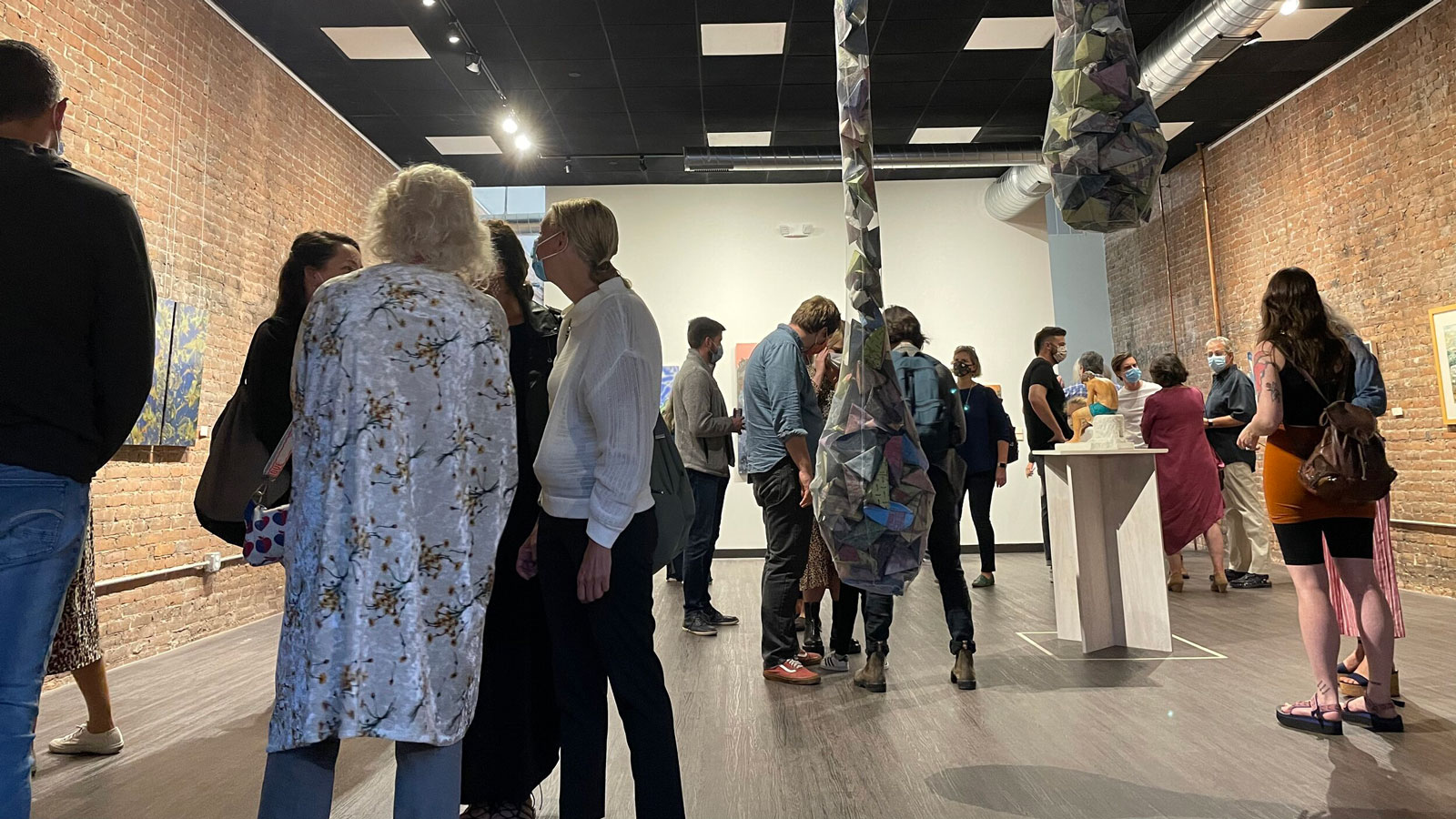
A student mentorship program, Step Up groups often have conversations with successful studio art alumni. Step Up group The Allens (senior leader Peter Loughlin ‘22, Sky Cohen ‘23, Brianna Callahan ‘25, and Mason Allen ‘25) met with Denison alum Sam Belisle ‘14, who has just begun as co-director of his own gallery, Nearby, in Newton, MA. Belisle graduated with his BFA from Denison in 2014, and his MFA from The School of the Museum of Fine Arts (SMFA) in 2018. Below is the transcript of their Feb. 2022 interview with questions about life after Denison, and what one graduate has done to continue making work, offer opportunity to artists, and give back to his community.
The Allens: What is your gallery’s mission statement?
Belisle: Our mission is to support emerging artists, help provide opportunities, but also generally just focus on emerging artists and the thoughts that come directly from them and their experiences.We don’t want to close people off, so we open it up to the language of “emerging artists.” This can be young people but also could mean people late in their life who are just starting their practice.
What I learned in Boston is that what’s being supported in academia is not necessarily being supported in the gallery scene. There aren’t a lot of apparent opportunities as an emerging artist, it’s almost like there’s a generational stronghold on the gallery spaces, so we wanted to create a space that acted kind of like a stepping stone for these artists.
We’re a young gallery and try to support artists any way we can. We take a 40 percent commission on sold work which is a little less than most spaces, and we do an artist retail space where a lot of artists can sell stuff to support their practice, and we do print sales for our artists. We don’t fancy ourselves curators or even consider ourselves to necessarily be interested in that, which is why we often bring in other curators or work with other galleries to develop shows and programs.
Our goal is to provide an opportunity because Boston is an expensive place to live in, especially for artists. So many people from our cohort had to leave and move back home or move somewhere else which is a little more affordable. So if we can keep people in Boston and keep supporting their practice, that’s what we want to do.
Boston has its own arts district, it’s in South Washington (SoWa), but we decided to go against the grain and not open our gallery in that community. Not only did we avoid it for some of the reasons I mentioned earlier but also the area is kind of desolate and you only really go there to see art. There really isn’t a fusion of any other cultural elements, restaurants, music, or anything else like that. So when we chose Newton, it was a multifaceted decision:
- Lots of new young business owners working there trying to shift the culture of Newton.
- There’s more foot traffic for the artists, more people to get in and see the work.
- It’s a pretty affluent community.
In terms of selling work for artists and finding collectors, it’s a smart move to “hit them where they live” and begin to foster their engagement with art.
The Allens: What led you to develop the art classes and community programming at the gallery you are co-directing, and what were some challenges you encountered in the process?
Belisle: The unfortunate thing is that when we got started, we got hit with a huge construction project for our building, so we had to pull the plug on our programming for a little while. We’re just now starting to get back to it, but initially we worked with our network of artists who were looking for opportunities and teaching experiences. Because we don’t have a huge budget and we want to get people paid, we built programming based on what they wanted to teach and their availability.
We rely a lot on the cohort we built during graduate school, and the community of peers. Since we’ve been at it for six months or so we’ve been approached by a lot of different educators and people from the community who want to be involved in the community outreach aspect.
I think offering art education to the community will go a long way in fostering an appreciation for the arts in the area which will, in turn, help give visibility to our artists.
The Allens: What’s a typical morning like for an artist living in Boston, MA?
Belisle: The gallery is kinda forcing me to get on more of a “real” schedule. It is difficult to make time for painting. Before that it was a whirlwind. I tried keeping a schedule since it’s so easy to get lost. Wake up, have coffee, paint for six to eight hours, then call it a day. Before the pandemic, the typical day was painting in the mornings and working in a restaurant in the evening. But now there’s barely any time to paint.
The Allens: …Barely anytime to paint because you’re busy with other jobs or because of the gallery?
Belisle: Since we opened the gallery. We’re a small team. It’s me and another artist with a couple of others helping us out, on a mutually beneficial basis. Lots of responsibilities for us to manage. On top of that, both Cal and I work other jobs. He does art handling, and I do odd jobs working on houses; painting, residential carpentry, etc. Whatever I can do to keep my schedule flexible, so I can be at the gallery.
The Allens: What is your inspiration when it comes to ideas?
Belisle: I definitely derive inspiration from music. I was a musician growing up. I was in multiple bands throughout school, all the way through Denison. I think that has a natural influence on how you think about things culturally. Certain influences in hip hop and other areas definitely come through.
I try to find areas that could be understood in multiple ways based on your context. I mentioned I do a lot of urban landscapes, so for a while I was taking spaces that mean one thing to one person and something else to someone else based on context.
I did a painting of an alleyway called “smoke break” that was kind of glorifying this space where you would go to take a five minute break from working, like if you were working in a restaurant. To me, it’s interesting how this spot can be a place of refuge for one person and something that can feel unsafe, uncomfortable, or misunderstood for someone else. Graffiti and alleyways - they have certain significance in entertainment and in reality that make people feel unsafe and differently about that space.
With that said, I’m really hooked on this idea of clashing perspectives of different classes. Actually, Denison had a huge influence on getting me to that point and realizing that’s what I wanted to focus on.
The Allens: I worked at a butcher shop in high school and two of my colleagues were avid smokers that would take five-minute smoke breaks throughout the day and hang around the side door at the supermarket. This was the same door I would walk through dreading my shift every day, yet that door was a safe space for them to enjoy their nicotine fix.
Belisle: Haha yeah, it’s fun to see those little spaces people create. Whether it’s sitting on a milk crate or making a card table out of found objects. I love studying those makeshift spaces.
The Allens: What is your most recent project in painting?
Belisle: I’ve been branching out a little bit. I’ve changed motifs a little bit in my painting, still working from my experience of working-class context in America. I draw a lot of urban landscapes, focusing on objects that are kind of religious to my experience. Ladders, paint buckets, things like that.
Recently, I’ve kind of shifted and obsessed with multiple forms of painting within a painting but still pulling from these religious objects like gas and electrical meters. Beyond that, I’m also diving more into three-dimensional wall hanging pieces that are a mixture of painting and also sculptural, working from my foundation in carpentry and residential painting. Bringing those elements, like studs and drywall into my painting in a three-dimensional way. That’s kind of where I am.
The Allens: Are there any particular artists that influence your style?
Belisle:
- Nicole Eisenman, a great people painter who captures candid, intimate scenes.
- Rirkrit Tiravanija though he is more performative, I love how he builds his spaces and engages the public with his work.
- I’ve always been interested in Kehinde Wiley and his graphic portraiture style. Getting involved with the subject and working with them on a one to one basis, I think that’s really important especially when you’re using someone’s likeness for something. When I do portraiture, I really try to emulate that and do it in similar ways; get involved and not just use them for another painting.
- Henry Taylor, he’s a great one. I love the way he depicts street scenes and people from his life who had an impact on him.
Other influences:
- Nari Ward
- Norman Rockwell
- Ben Shahn
- Diego Rivera
- Frida Khalo
- David Hammon
- Kerry James Marshall
- Andrew Fish
- Rashid Johnson
The Allens: What is your process from the formation of an idea to executing it?
Belisle: It’s a mixture of both research online and going out into the world to find inspiration. I’m still in a place where I’m figuring out my work aesthetically (though I’ll probably be there forever), so I do still take my own pictures, draw them, and draw from pictures online for convenience. It’s getting to a point now where I’m not trying to take moments from life and reproduce them, I’m trying to introduce drawing again and make it more interesting, give it a more unique quality.
I started to use my iPad to plan paintings because before I used to just dive in but I realized that if I’m trying to exhibit work at shows and galleries, it’s just not an efficient process to not know exactly where I’m going. I started building collages on Procreate or Photoshop and working from those — It’s been helpful in streamlining the process.
The Allens: What’s next for you?
Belisle: I’m pretty excited for it to get warmer out so I can get back into my studio practice and develop the next body of work I’m working on. As far as the Nearby Gallery goes, we have a lot of plans. We’re doing a show next month with the School of the Museum of Fine Arts, my alma mater. We’re trying to get a couple of larger name artists next year and beyond that, just get our classes back up and running.
The Allens: Is there anything else you would like to add? Or any advice you’d like to share with Denison Studio Art students?
Belisle: Yes, absolutely. One of my professors told me when I was at Denison and thinking about graduate school that I should not rush into it and take some time off. I think that was the best advice I ever had because I took four to five years off in between and I worked as a house painter, residential maintenance, phone sales, and that work experience really allowed me to focus on what I wanted to do in art and what I wanted to keep doing in general.
It also gave me a certain skill that students who were going straight from undergrad to graduate school didn’t have. And that was the ability to navigate my time and know exactly what I wanted to do. Although everyone eventually made it through, I think it’s really about what you get out of it is what you put in, especially as an artist. So if you’re not prepared and not focused, I think you’re just wasting money and wasting time.
My advice is to take some time off and figure out what’s important to you. Grad school might be an option and it might not be, it’s definitely not always necessary. And my other advice is once you get going, you have to realize that it’s not going to be the ideal project every time, and you have to get used to saying “yes” to things. And as long as you’re not compromising things ethically or morally, just say yes to things because one project can lead you to the next. You’ll meet the next person who wants to support you for something.
One of my other professors said one of the biggest things about being an artist is putting yourself out there and being able to connect and build a community. This network that you guys have fostered with the Step Up group is really important. If I didn’t decide to go to grad school, I wouldn’t have had as large of a network of friends as I did. I had a group of friends I was comfortable with at Denison, but not nearly enough.
It’s your livelihood, you have to support each other and that’s really the only way to make it in this game.
This conversation happened as a part of the Step Up mentorship program.
The Step Up Program is a mentorship program where seniors are paired with junior, sophomore, and first-year studio art majors to create a community that spans all years of study at Denison. Step Up Groups are an effort to foster support for majors, as well as deepen relationships and investment. Each semester students spend time meeting for studio visits, as well as taking charge of various projects within the studio art department and coming up with their own projects to improve the Bryant Arts building.



